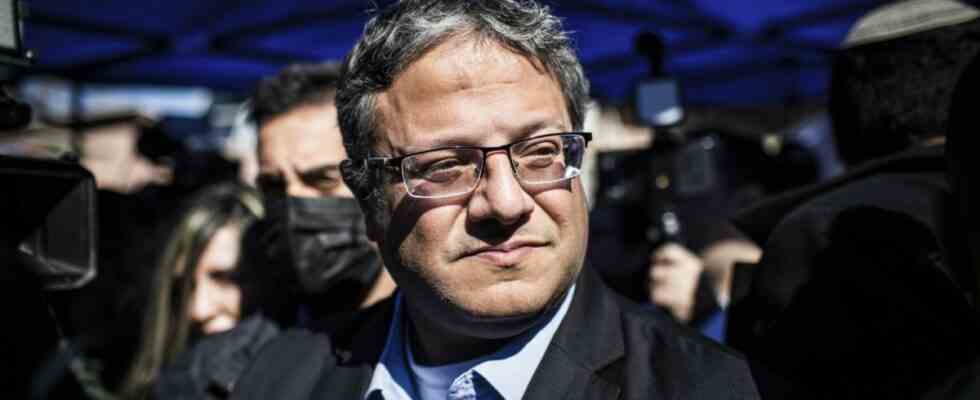A few days ago he drew his gun in the middle of East Jerusalem, in the middle of a violent clash between Arabs and Israeli security forces. When there were signs of rioting, Itamar Ben-Gvir and his entourage immediately rushed to Sheikh Jarrah and shouted to the Arab residents living there that the “master of the house” was here. When stones flew, he drew his pistol. He didn’t shoot, instead he asked the Israeli police to open fire on the stone throwers. And he was so proud of his action that he posted a photo of himself with the gun afterwards.
Where there’s fire, Ben-Gvir likes to be there with the oil barrel. He pursues politics as a permanent provocation, and with racist slogans and hatred of Arabs he has come a long way in the current Israeli election campaign. The Religious Zionists, for whom he will stand on November 1, are the sensational climber in all polls. Instead of the previous six, 12 to 14 mandates are now being predicted for them. They are likely to become the third strongest force in the 120-strong parliament – and a strong pillar for Likud leader Benjamin Netanyahu, who wants to regain power with a right-wing religious bloc after a good year in the opposition.
Ben-Gvir first attracted public attention when he threatened Yitzhak Rabin
So Ben-Gvir and his family can hope for ministerial posts in a government unlike anything Israel and Israel’s friends around the world have ever seen. Warnings are already coming from Washington, from Jewish groups and the Democratic Party, that this could do more than just damage the country’s image. But as a precaution, the Religious Zionists are already demanding up to five cabinet posts, including the departments of defense, finance and justice.
The successors to a movement that was banned in Israel in the 1980s could rise to the center of power. Ben-Gvir is one of the students of the Rabbi Meir Kahane, who advocated the elimination of liberal democracy and the expulsion of the Arabs from Israel. Kahane was killed in an assassination attempt in New York in 1990, and Ben-Gvir continued the fight.
The 46-year-old first came to public attention in 1995 at the height of the dispute over the Oslo peace treaties, when he removed the Cadillac emblem from the then Prime Minister’s company car Yitzchak Rabin held up to a camera and announced: “We got to his car, we can reach him too.” A little later Rabin was murdered by a Jewish extremist.
Long-serving Prime Minister Benjamin Netanyahu wants to return to power, and he has joined forces with extremists to do so.
(Photo: Abir Sultan/dpa)
As a lawyer, Ben-Gvir later specialized in the defense of Jewish radicals. At home in Hebron, where he lives as a settler with a wife and five children, he curled up under a picture of Baruch Goldstein, who in 1994 massacred 29 Muslims at the patriarch’s tomb, killing 29 people. In the current election campaign, he is sometimes more moderate and asserts that Goldstein is “no longer a hero” for him.
For many of his supporters, however, he is now a hero himself when he flies the flag at the hotspots of the conflict. On Jerusalem Day at the end of May, he marched through the Damascus Gate into the old city, surrounded by a retinue chanting “Death to the Arabs.” He now also enjoys voting in Tel Aviv, the stronghold of the left and liberals in Israel. In the south of the city, he recently led a demonstration against the migrants living there, who the right-wingers call “illegal invaders”. He also appears in schools and likes to post how he is being celebrated by young fans there.
The country is shifting to the right, and young people in particular are contributing to this
Ben-Gvir is pushing into the mainstream, and he has two helpers: the zeitgeist – and Netanyahu. The zeitgeist stands for the shift to the right that has been observed in Israel for some time. one Study by the Israel Democracy Institute According to this, 60 percent of Israelis belong to the right-wing camp. In young people it is even 70 percent. Apparently, Ben-Gvir and his comrades-in-arms have now become socially acceptable for a growing number of people.
Netanyahu made sure of that. In the previous election in March 2021, he pulled the strings for a merger of Ben-Gvir’s Otzma Jehudit (Jewish Strength) party with Bezalel Smotrich’s Religious Zionists and the explicitly homophobic Noam party. The aim was not to waste a single right-wing vote by failing at the 3.25 percent hurdle. Ben-Gvir, whose party founded in 2012 had previously only been a marginal force on the right-wing fringe, entered parliament with fanfares for the first time. He then made good use of this stage.
Netanyahu remained the driving force in the run-up to the current election. When Smotrich and Ben-Gvir began to quarrel, he invited the two to his mansion in Caesaria and pressed them into a new electoral alliance. Since then, according to Israeli media reports, Netanyahu and Ben-Gvir have met regularly to chart the course.
However, Netanyahu could face the fate of the sorcerer’s apprentice, who can no longer control the spirits he has summoned. Because part of the increase in votes of the Religious Zionists could be at the expense of the Likud. At an event on Monday, this had a curious consequence. Ben-Gvir was on the stage, Netanyahu was to be the next speaker. But to avoid a photo together, he reportedly stayed in his car until Ben-Gvir actually left.

